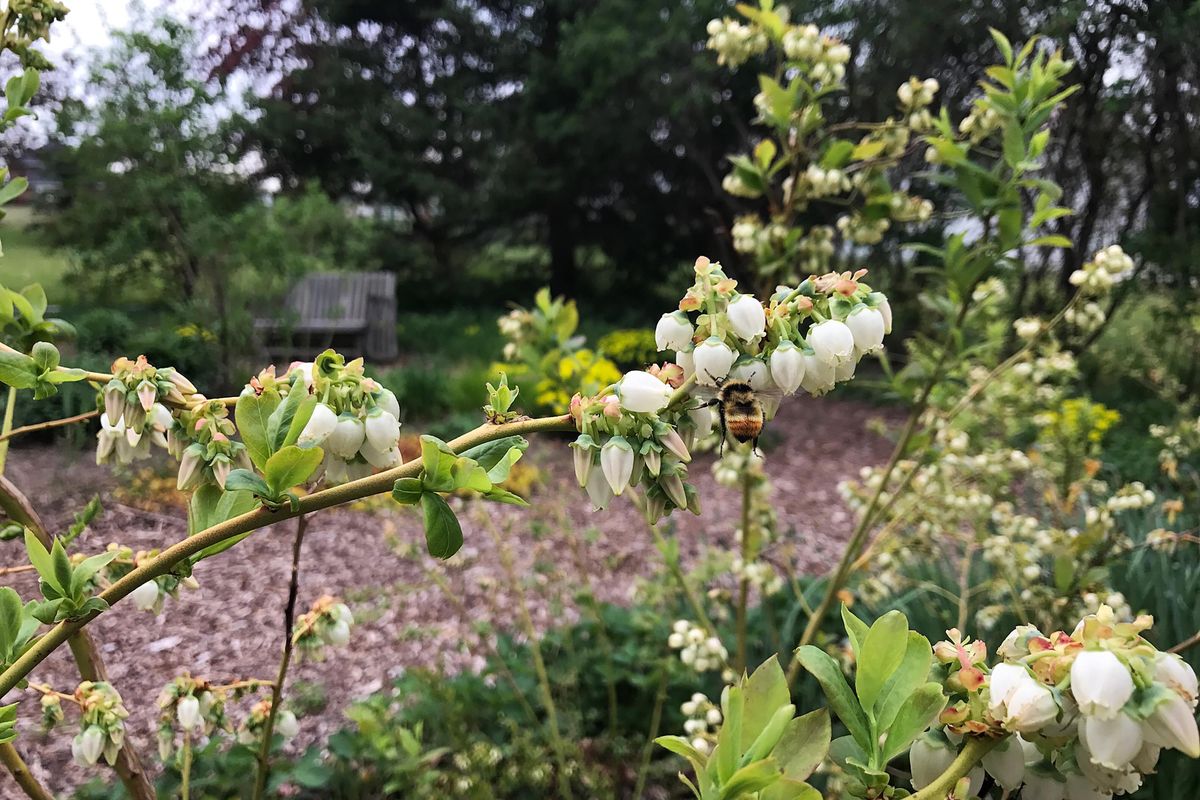In the Garden: Blueberries provide a delicious harvest, plus beauty in the landscape

When you look at what a tiny package of fresh blueberries sells for at the grocery store, you would think they’re difficult to grow. Fortunately, nothing could be farther from the truth provided you meet the plants’ basic needs.
I’ve grown blueberries for about 25 years and, aside from the delicious harvest they provide, I appreciate what they contribute to our landscape. In the spring, the bushes are covered with cream-colored flowers that bumblebees clamor over to get their sweet nectar. Those flowers are followed by green berries that gradually turn blue in July. Come fall, all eyes are on the leaves as they transform from green to a vibrant red.
The three primary needs of blueberry bushes are plenty of sunshine (with a bit of afternoon shade), regular watering, and acidic soil with a pH value between 4.5 and 5.5. Because the average soil pH in this region ranges from 7.0 to 7.5, it’s a good idea to conduct a simple pH test using a kit from a garden center first.
While some advocate the use of peat moss to lower the soil pH, it’s not a sustainable practice because peat bogs take thousands of years to develop. I prefer using elemental sulfur, which is available at garden centers. The label directions will indicate the amount to use, based on your soil’s pH and the size of your garden bed. There are online application calculators as well.
Every two or three years, apply more sulfur to the bed by sprinkling it onto the surface of the soil. Blueberry plants have very shallow roots so digging it in isn’t an option. You’ll also want to be careful when weeding for the same reason.
Choosing blueberry cultivars is an exciting part of establishing a blueberry bed. Even though the plants are self-fertile, you will get much better production by selecting more than one cultivar so they can pollinate each other. Before you do that, however, there’s one more consideration: there are early, mid- and late season cultivars. I recommend picking out a couple of each – provided you have the room for them – to extend the harvest season as long as possible.
Of the early-season cultivars, Patriot is my favorite because the berries are huge. Earliblue, Blueray and Spartan are other examples that do well in this region. Mid-season cultivars include Bluejay, Bluecrop and Berkeley. Darrow and Elliot are late-season cultivars.
When harvest season arrives, it’s important to be patient and only pick berries when they have turned a deep blue. They will be the most flavorful.
You might discover that birds – particularly robins – are helping themselves to your crop when you’re not looking. I cover our blueberry bed with a large sheet of floating row cover because the lightweight fabric keeps the birds away but allows sunlight and moisture to get through it. I used to cover the bed with bird netting but berries can get caught in it so easily. The berries would fly everywhere when I uncovered the bed in order to pick them.
What about pruning blueberry bushes? For the first two years, leave them alone other than to remove broken branches. It is recommended to strip off the blossoms for the first two years so the plants focus on getting established rather than producing fruit. I’ll let you decide if you can be that disciplined.
In early spring of their third year, it’s time to do some pruning. Remove dead or weak branches first, then branches that cross each other. The main pruning goal is to have a balance of 1-, 2- and 3-year-old canes, which are what the branches are officially called. How do you know the difference?
The 1-year-old canes and 3-year-old canes are the easiest to identify. The former are smaller in diameter and yellow-green in color while the latter are covered with thick, light brown bark. The 2-year-olds have a reddish tinge and are partially covered with brown bark.
One of the things I love most about blueberries is that they need absolutely no preparation in order to eat or preserve them. For freezing, just place the berries into freezer bags and pop them into the freezer to enjoy during the off-season.
Having fresh berries to pop into your mouth while out in the garden, for your morning yogurt or oatmeal, or for muffins, tarts and pies is your reward for the little bit of care the bushes require.
Susan Mulvihill is co-author, with Pat Munts, of “Northwest Gardener’s Handbook.” Contact her at Susan@susansinthegarden.com. Watch this week’s “Everyone Can Grow A Garden” video on youtube.com/c/susansinthegarden.